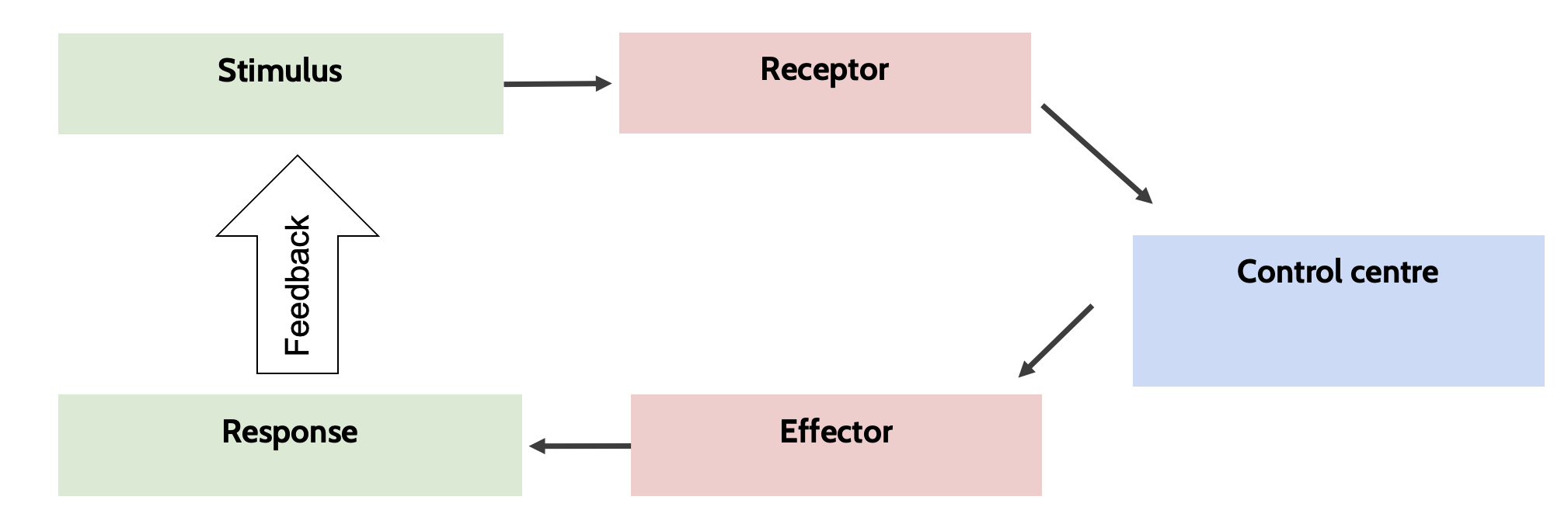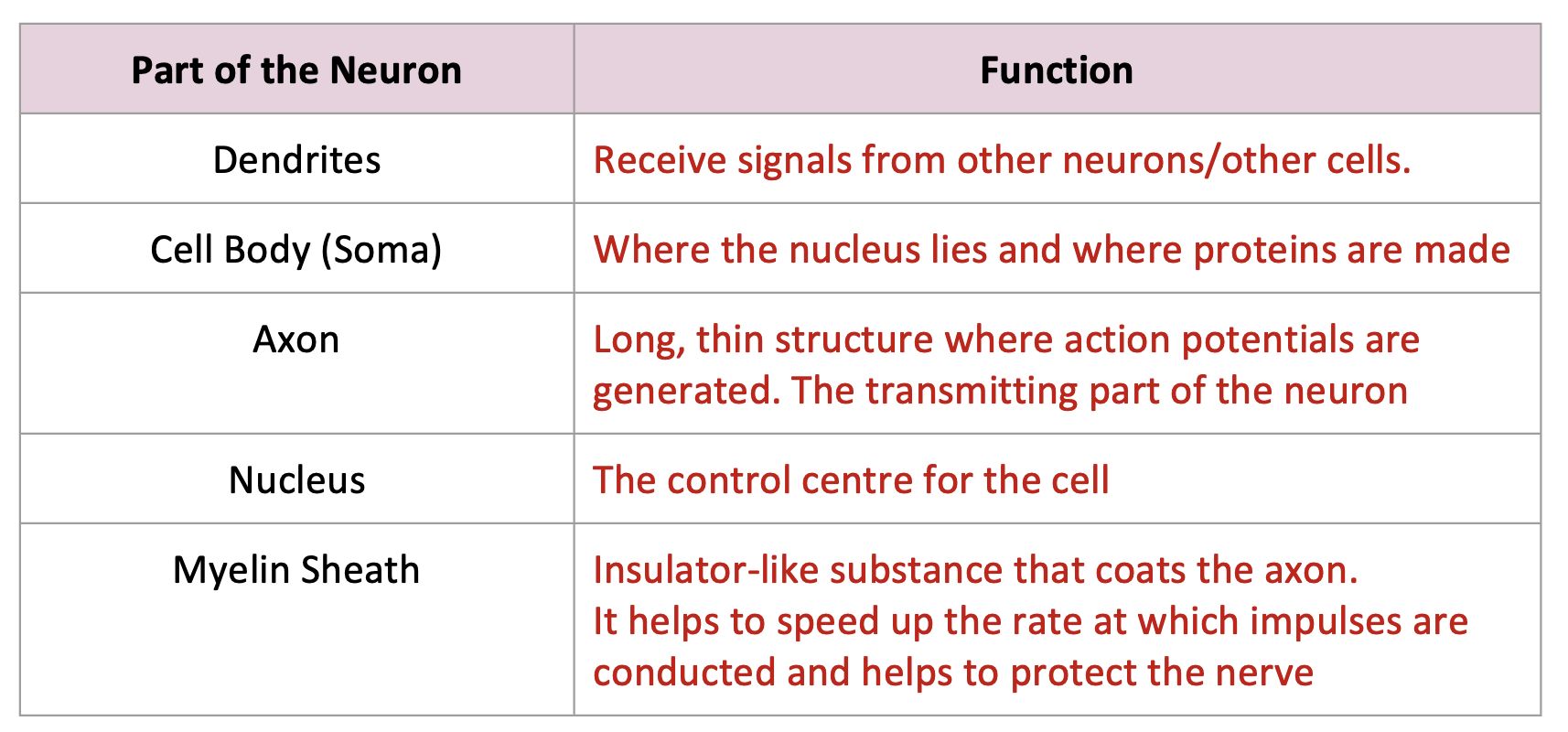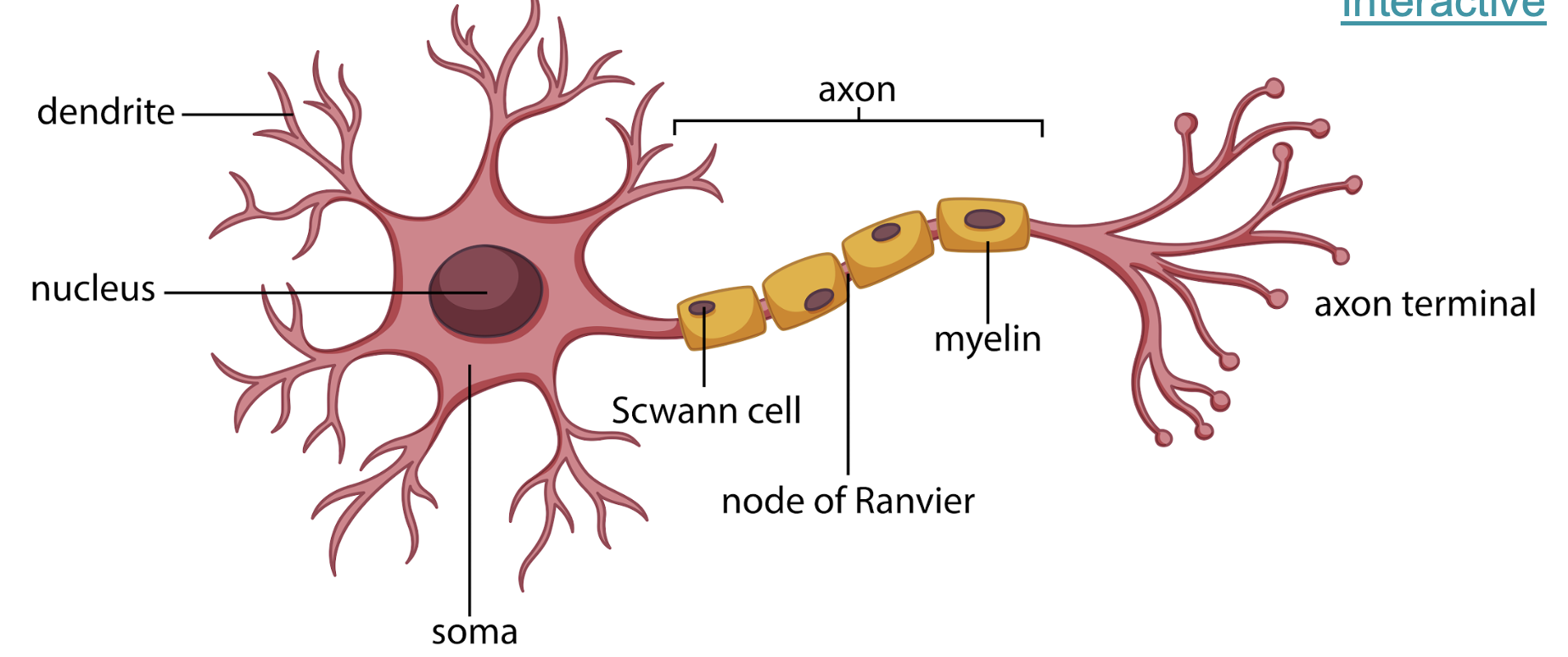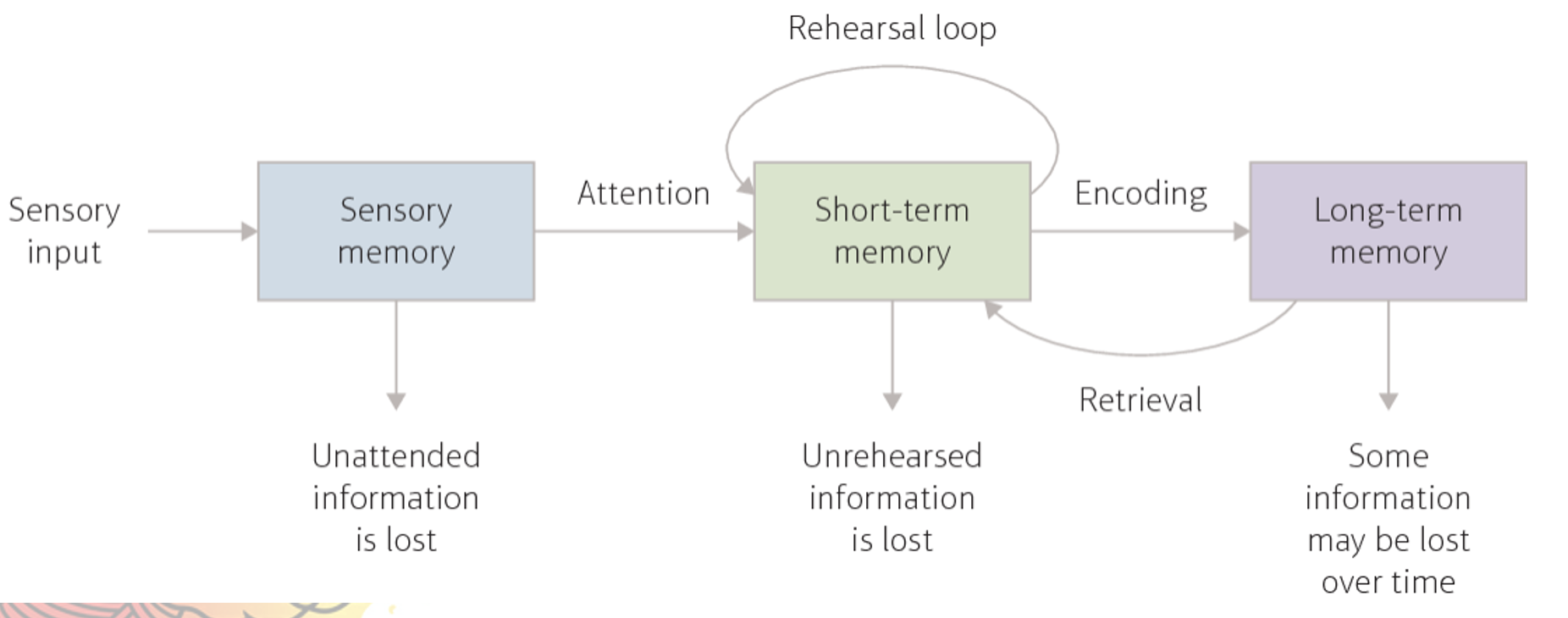Science Exam Revision: Phycology
1/47
Earn XP
Description and Tags
These flashcards cover key terms and their definitions related to homeostasis, coordination, the nervous system, and memory as discussed in the lecture.
Name | Mastery | Learn | Test | Matching | Spaced |
|---|
No study sessions yet.
48 Terms
Homeostasis
Maintenance of a constant internal environment despite external changes.
Coordination
The ability of different organs and systems to work together effectively in a multicellular organism.

What happens if our bodies did not have homeostasis?
The body would:
Starve
Run out of usable energy
Dehydrate
The cells in out body would swell up and burst
Suffocate
Stimulus Response Model
To achieve homeostasis, the body must detect changes within the internal or external environment. This process can be summarised by the stimulus response model.

Receptor
Specialised nerve cells that detect stimuli and signal the control centre. Types of receptors include:

Control Centre
Specialised cells in the brain and spinal cord that process information from receptors.
Effector
A muscle or gland that responds to signals from the control center.
Negative Feedback
A control mechanism that reduces the output or activity of a system to stabilise it. Reverses direction of change.

Positive Feedback
A control mechanism that increases the output or activity of a system to amplify changes. E.g. Pregnancy.
Aim
States the purpose of the experiment. It should directly relate the variables in the hypothesis and describe how each will be measured.
Hypothesis
It links the independent variable and the dependent variable.
Graphs
Must include:
A precise title linking the independent and dependent variable.
Both axes are labelled and have the measurement.
The intervals are even.
Points are accurately plotted.
The graph maximises the space provided.
The graph is clear and neat. It shows the trend of data.
Tables
Must include:
A precise title linking the independent and dependent variable.
Be ruled and clearly set out.
A precise column heading.
Have the units of measurement in the column heading.
Research question
A question that links the IV and DV and is often the title for the experiment. E.g. Will subjects with a bacterial infection have a higher concentration (mg/L) of white blood cells?
Conclusion
Must include:
Answer the aim.
State whether the hypothesis is supported or not.
Describe overall trends
The Nervous System
A complex network of nerves and cells that transmits signals between different parts of the body, coordinating responses to internal and external stimuli.
Functions of the Nervous System
The 3 main functions are to:
Receive information
Process information
Coordinate a response to information
Central Nervous System (CNS)
The part of the nervous system comprising the brain and spinal cord, responsible for processing information and coordinating responses.
Peripheral Nervous System (PNS)
The part of the nervous system that lies outside the central nervous system, consisting of nerves and ganglia that connect the CNS to limbs and organs, facilitating communication throughout the body.
It can be broken into the autonomic and somatic systems.
Autonomic Nervous System (ANS)
Part of the PNS that controls involuntary bodily functions, such as heart rate and digestion, and is divided into the sympathetic and parasympathetic systems.
Somatic Nervous System (SNS)
Part of the PNS that controls voluntary movements by transmitting signals from the CNS to skeletal muscles.
Sympathetic Nervous System (SNS)
A division of the autonomic nervous system that prepares the body for stressful or emergency situations by increasing heart rate, dilating airways, and inhibiting digestion.
Parasympathetic Nervous System (PNS)
A division of the autonomic nervous system that promotes rest and relaxation, decreasing heart rate, constricting airways, and stimulating digestion.
The brain
Also known as the control centre, the brain is the central organ of the nervous system, responsible for processing sensory information, coordinating responses, and regulating various bodily functions.
The spinal cord
A vital part of the central nervous system, the spinal cord transmits signals between the brain and the rest of the body, and is involved in reflex actions.
Receives sensory information from the PNS and sends it to the brain for processing.
Receives motor information from the brain to the body and coordinates responses to the environment.
Damaged spinal cord
Can result in loss of sensation and motor function below the injury site, significantly affecting mobility and bodily control.
Neuron
A nerve cell that transmits electrical impulses and communicates signals throughout the nervous system.
They are the building blocks of the brain and nervous system.
Neuron functions
The 3 main functions are to:
Receive information
Process information
Communicate information to target cells
Types of neuron
Sensory neuron
Motor neuron
Interneuron
Sensory Neuron
Specialises in sending sensory information to the CNS
Motor Neuron
Specialises in transmitting signals from the CNS to muscles and glands.
Interneuron
Functionally connects sensory and motor neurons within the CNS, facilitating communication between them.

Structure of a Neuron

Soma
The soma, or cell body, is the central part of a neuron that contains the nucleus and organelles essential for the neuron's metabolic activity.
Dendrites
Dendrites are branched extensions of a neuron that receive signals from other neurons and transmit the information toward the soma.
Signals can either be excitatory or inhibitory, influencing whether an action potential is generated.
Excitatory: increases the likelihood of firing an action potential.
Inhibitory: decreases the likelihood of firing an action potential.
Axon
The axon is a long, slender projection of a neuron that conducts electrical impulses away from the soma toward other neurons or muscles. Towards the end of the axon, signal transmission occurs at the axon terminals, where neurotransmitters are released. It serves to transmit neural information (action potentials) and communicate with other cells.
Myelin Sheath
A protective layer that surrounds the axons of some neurons, facilitating faster transmission of electrical impulses during action potentials. They are made out of Schwann cells which are made of fat and protein and they act like insulation on an electrical wire.
Nerves
Bundles of axons that transmit signals between the central nervous system and various parts of the body, facilitating communication throughout the nervous system.
Reflex
An involuntary and automatic response to a specific stimulus, involving a neural pathway known as a reflex arc that enables quick reactions without conscious thought.
Reflex arc
Is the neural pathway that mediates a reflex action, consisting of a sensory neuron, an interneuron, and a motor neuron.
Communication between Neurons
Refers to the transmission of signals across synapses, allowing neurons to share information through chemical and electrical means.
Learning
The acquisition of new knowledge or skills through experience, study, or practice, often resulting in a change in behavior.
Memory
The mental capacity to store, retain, and later retrieve information or experiences.
What is the relation between learning and memory?
Learning and memory are closely related cognitive processes; learning involves acquiring new information, while memory is the ability to retain and recall that information later.
Learning would have no value if we could not remember it.
Neuroplasticity
The brain's ability to reorganize itself by forming new neural connections throughout life, allowing for changes in learning and memory.
Stages of memory
The processes by which encoding, storage, and retrieval occur to create memories, typically categorized into sensory memory, short-term memory, and long-term memory.
The Atkinson Shiffrin Model

How are memories made?
Memories are made through a process involving three key stages: encoding information, storing it for future use, and retrieving it when needed. This complex interplay allows us to create and access memories effectively.